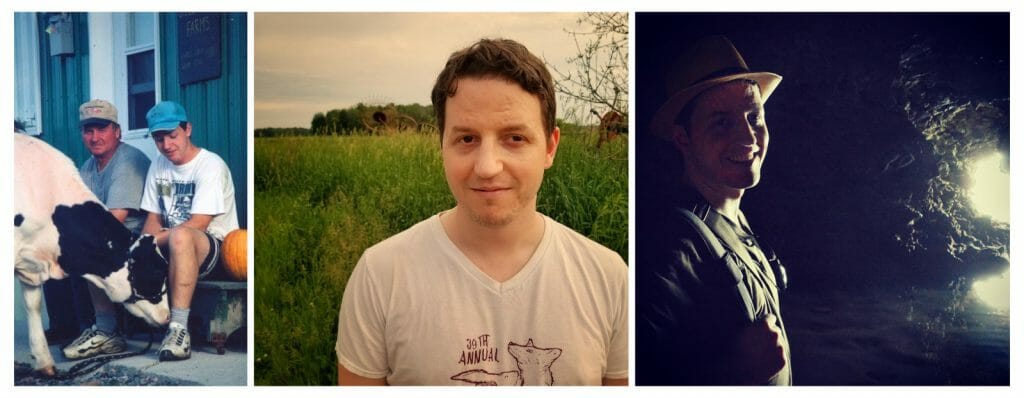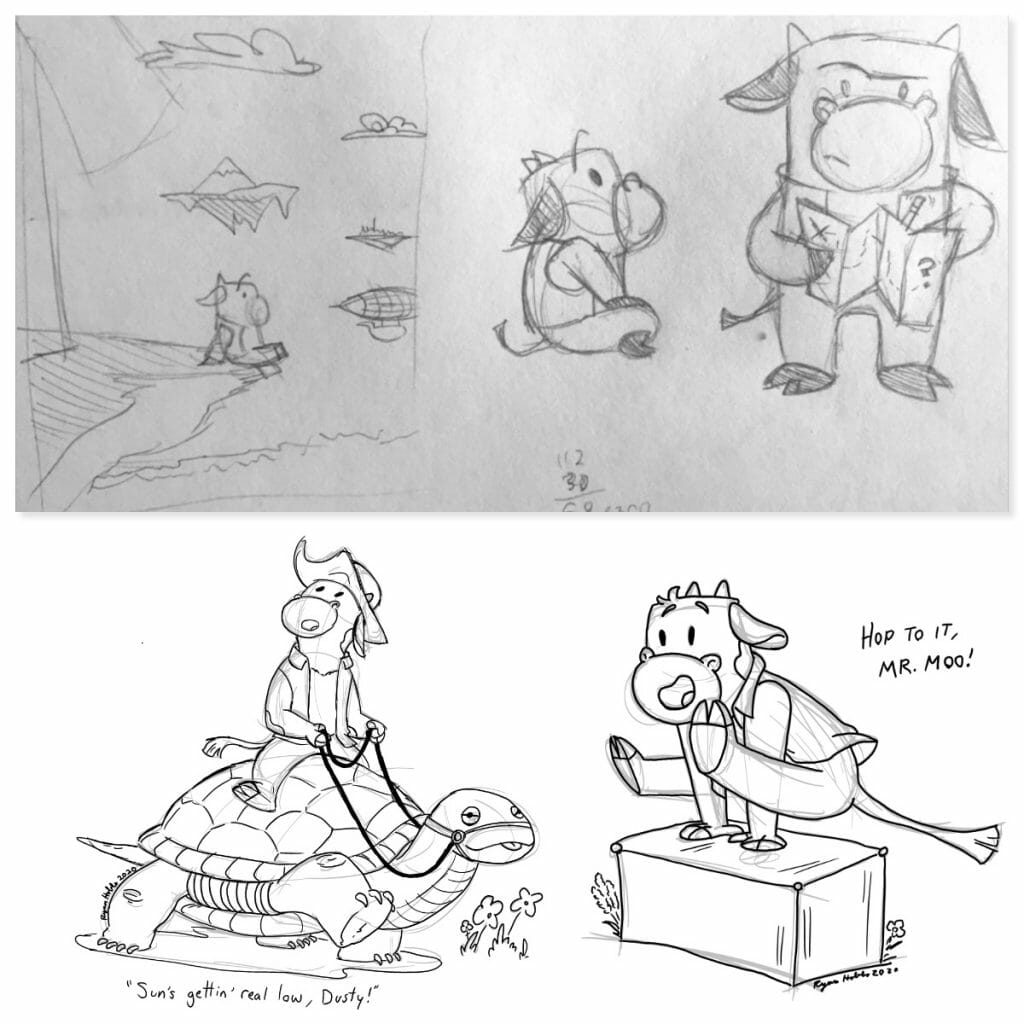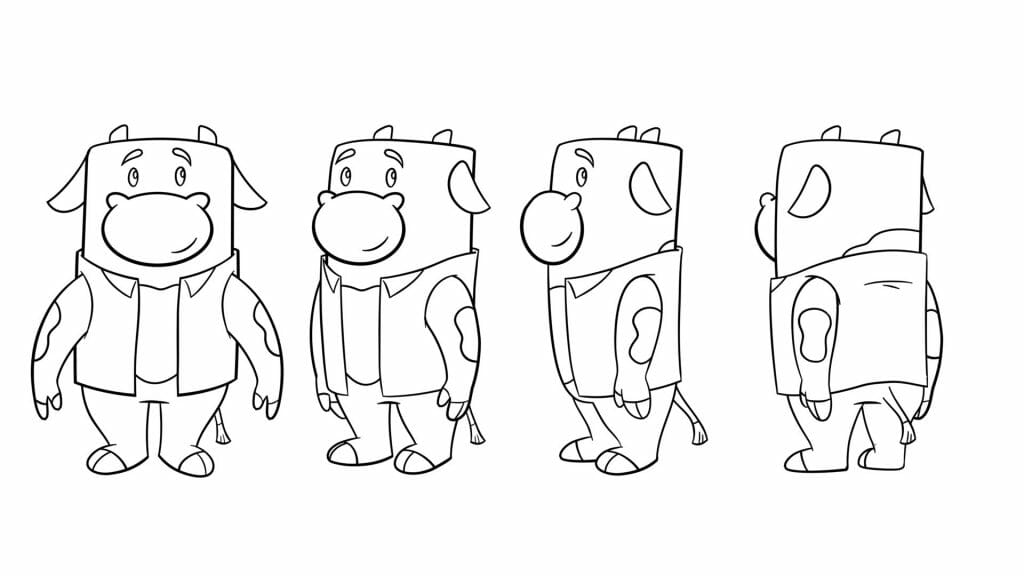Moo’s First Map follows Clarence Mooney as he heads out on his first charting expedition. He faces challenges, but also victories, as he journeys across a mystical floating island. This short film, by Ryan Hobbs, explores how one character overcomes his fear and anxiety about the unknown, and discovers a big, beautiful world.
Ryan Hobbs is an animator, trainer and animation supervisor who has worked at Mercury Filmworks since 2005. Ryan was selected as part of the second wave of Mercury Shorts to create his film, which features detailed character rigs and ambitious background design. The Mercury Shorts program provides artists working at the studio with an opportunity to work closely with Mercury’s development team to create their own animated shorts. We caught up with Ryan to learn more about the making of Moo’s First Map, from his inspiration for characters to his journey producing the short.
Could you start by sharing with us your journey into animation, and your career so far?
The earliest point in my life where I actually understood animation was when I was around 6-years-old and started watching the old Astro Boy cartoons. At the end of the episodes during the credits they’d have a still image of Astro Boy in a running pose, and then in slow-motion they’d put the next frame, followed by the next frame, and the next, and so on, speeding up until it was at normal animation pace.
Seeing that made animation click for me. I realized that when I’m watching a cartoon, they’re just drawings; cycling through one after another. I didn’t yet understand the nuts-and-bolts of animation, but I had a grasp of the basic concept.
My drawing journey also began at a very young age. In kindergarten I loved drawing the Ninja Turtles. I’d have one of the pictures from the Ninja Turtles comics, and I’d try my best to draw that classic group pose where they’re popping out of the sewer holding their weapons.
I grew up on my family’s farm in Quebec and I knew I didn’t want to do that for a living. So I joined the visual arts program at Heritage CEGEP in Gatineau. While there, I made a friend who was already in Algonquin College’s animation program, which sparked my interest in animation. After one year at CEGEP, I got into Algonquin’s program. After that, I got into the animation industry. It was 2005, and Mercury Filmworks was looking to hire. They took a big scoop of graduates from Algonquin, and I was one of them. And now I’ve been at Mercury for 17 years!
What story does Moo’s First Map tell?
Moo’s First Map follows Clarence Mooney (also known as Mr. Moo) on his first official charting expedition. He’s exploring a floating island and is nervous about facing the unknown. On his journey across the island, he encounters creatures, wonders, and challenges. He charts all of them on his map as he goes. Some of Mr. Moo’s new experiences are a bit uncomfortable, but he pushes onward. His sense of wonder grows and he becomes more confident. Ultimately he finishes his expedition by climbing to the summit of a mountain, where he has a beautiful view of the floating island that he just explored and charted.

What was your inspiration for Moo’s First Map?
Mr. Moo is actually a character I’ve been drawing for years, for a show pitch that I’ve been working on. The show is about a world of airships, floating islands, discovery and drama. For the shorts program at Mercury, I wanted to make a small, self-contained little tale about Mr. Moo. My connection to cattle comes from the farm I grew up on. It was a beef and dairy farm, so I spent a lot of time around cows.
As for the maps, I’ve always enjoyed maps and exploration in games. I remember playing Final Fantasy, and, as I crossed the world map in the game, I would wonder what was over the next horizon — or the edge of the screen. I’d wonder where the next town or next landmark would be. Super Mario World’s map always excited me too. As you beat levels through play, you unveiled more of the map in the distance and could travel there. Our family vacation when I was seven was to go to Disney World in Florida, and I instantly took to the cartoony maps they had of the park. I recall my parents letting me guide the way around the park’s attractions.
Another source of inspiration is playing Dungeons & Dragons and other fantasy adventure games. In these games you’re often exploring the world with friends. There’s a sense of not knowing what you’re traveling towards in these games. What you come across could be scary, but you want to go anyway because what you find could be really cool.

How did Mercury Filmworks support the making of Moo’s First Map?
To start with, I was given dedicated work days. Rather than working on my usual Mercury Filmworks projects, I could spend the whole paid work day focused only on Moo’s First Map. I had one of these dedicated Moo days, once per month, over the course of four months. I still had to put in significant personal time towards work on the short, but those dedicated work days were invaluable because I could focus just on the film for many hours on end.
In addition to that, the production staff who were minding us were super helpful. They would check in with me on a regular basis to see how Moo’s First Map was progressing. Some artists can struggle with time management, and so having that routine check-in was a great way to keep me on track. It helped me keep sight of milestones and goals throughout the production of the short.
It was also helpful to consult with other creators at Mercury about my film. For example, Heath Kenny worked in story development for quite some time. He looked over an early draft of Moo’s First Map with me to give me feedback about the plot of my film. Heath encouraged me to think more about how to make it clear what Mr. Moo is feeling throughout the film. Cute stuff was happening to Mr. Moo, but Heath’s question was, “why do the viewers care about him?” Heath helped me hone in on Mr. Moo’s emotional journey, and find ways to make that journey really come across for the audience.

The background designs for Moo’s First Map stand out. What techniques did you use?
I have a small confession to make, here. You might notice that in the end credits of the film there are several people thanked for their work on the backgrounds: Jean-Marc Paradis, Gautam Kumar, Paul Nefedov and Bruce Skinner. There was a prior Mr. Moo teaser short that I made, which was around 20 seconds long. For this proto-version, which I made years ago, I actually commissioned backgrounds. I’m not a background artist myself, and I wanted a pro looking background for the short.
I commissioned Jean-Marc Paradis — who was my very first animation supervisor in 2005 — for the layout line work and Paul Nefedov for the painting. I still had access to all the files for these backgrounds. So for some of the shots of Moo’s First Map I was able to reuse the old files. I did rearrange and add to them, like flipping them upside down, adding overlays and such. But using these backgrounds for some of the shots was super-efficient.
The one background that I felt most intimidated by, not even with some creative reusing, was the final shot. It’s that beauty shot that shows Mr. Moo looking out over the floating island that he’s just journeyed across. That shot was Bruce and Gautam’s work. It turned out beautifully, I really appreciated their assistance with it.
The background that I was really committed to doing entirely without help was the actual map that we get to see Mr. Moo’s hoofprints travel across between the character animation sequences. The map is being drawn by Mr. Moo, who isn’t an amazing artist yet, and so any discrepancies in the map would make a lot of sense in terms of the film’s story. Using Procreate on my iPad, I drew my own fantasy map, painted it, texturized it, and created chalky, thicker outlines so it would look like Mr. Moo had drawn it himself with a pencil.
The chef’s kiss for me was using blurring modules during the map sequences in the animation, so that the colour layer faded into view as Mr. Moo’s hoofprints traveled across the map.

Could you talk a bit about your process for developing Mr. Moo, and building his rig?
I’ve actually been drawing Mr. Moo for years. And I still have the very first, original drawing of him. In the early designs, Mr. Moo was way more rectangular in shape, and he had a grumpy look to him. His rectangular shape, at that time, was because I would draw him after a whole day of work, when I just wanted to draw something simple. Instead of a detailed character, I wanted to use shapes to scribble something quickly.
From this original drawing, he got iterated on over the years. At one point, I started drawing him with a vest, and he got younger over the years too. He’d started out as a serious character, but in my mind he evolved into a young adventurer.
When I developed the design for Mr. Moo’s Toon Boom Harmony character rig, I wanted him to have a relatively small colour palette and clear lines that don’t rely on tons of detail. There’s more that could be added — flecks of hair, textures, etc. — but I wanted to keep it simple.
Speaking of the rig, I have another confession to make: A couple years ago I commissioned Nathan Dickey, a supervisor in the Character Builds and Prop Department here at Mercury Filmworks, to create the rig based on my designs so that I could save myself time in making my first Mr. Moo short. For Moo’s First Map, I repurposed that original Mr. Moo rig. I amended the rig myself into a newer version that reflects how his design has evolved since that first short.
What advice would you give to artists who want to work on their own personal animation projects?
From working on my own animation projects, I’ve learned that it’s really easy to assume things about other people’s jobs. You might think that painting a background or building a rig doesn’t take much time, so when you try to do it yourself it can be a bit of a shock. My main piece of advice is to never feel too precious about getting help. I’d commissioned a couple parts of that first Mr. Moo short film that I made, because it was a way to save myself time. It meant I could rely on the expertise of others to help me make the film I’d imagined.
Turning to others for assistance is never a bad thing, and it doesn’t mean your finished film is any less yours. The best part is you can use those commissioned pieces to save time in the future by repurposing them, like I did in Moo’s First Map.
Another piece of advice would be to remember that good enough genuinely is good enough. As artists, we often battle against this sense of perfectionism. And I think it comes out especially when you’re working on a project that is meaningful to you. There’s no such thing as perfect, though. You risk burning out if you feel like you aren’t allowed to make mistakes. Revisions, feedback, mistakes, are all a part of the process. I find the most healthy approach is to strive for a balance of pushing yourself to do a bit better than the last thing you made, but without being so hard on yourself that you’re discouraged before you even start.
Also, work within healthy timeframes. Contrary to popular belief, pulling all-nighters in school or work doesn’t really make for better work; it makes for tired animators. Your physical and mental health matters, and you matter beyond anything that you might create! Part of making a healthier self and a healthier animation industry is being able to set appropriate boundaries.
Do you have any upcoming personal projects?
At the moment I don’t have any big personal projects on the go, but I plan on sharing some Mr. Moo art on Instagram! So keep an eye out for that.
- Might a career at Mercury Filmworks be on your map? Visit the studio’s current job openings in Ottawa.
- Looking for other original shorts developed by talent at Mercury Filmworks? Be sure to visit the studio’s YouTube channel and read our other Mercury Shorts interviews.
- Ready to see more from Ryan Hobbs and the world of Moo? You can follow Ryan on Instagram.
The post Ryan Hobbs charts the journey behind Moo’s First Map appeared first on Toon Boom Animation.
Courtesy: https://www.toonboom.com/ryan-hobbs-charts-the-journey-behind-moos-first-map






